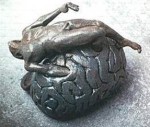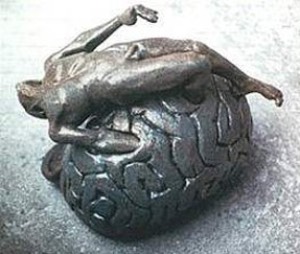
 Bodo Wentz, Fallsucht, Keramik, 1983, Deutsches Epilepsiemuseum Kork in D-77694 Kehl-Kork.
Bodo Wentz, Fallsucht, Keramik, 1983, Deutsches Epilepsiemuseum Kork in D-77694 Kehl-Kork.
On October 3, 2016, a poll conducted by the Odoxa Institute, commissioned by la Fondation Française pour la Recherche sur l’Épilepsie (French Foundation for Epilepsy Research), showed that one in ten French people considered epilepsy to be supernatural, and nearly seven out of ten French would be willing to rule out an epileptic person. To this day, due to a lack of knowledge of populations, epilepsy still suffers from a negative image in our society.
For centuries, the “sacred disease,” as Hippocrates called it, has generated the repulsion of society. Because of the violence of the epileptic attacks, the sufferer was marginalized. In the Middle Ages, the mystery that covered a disease considered supernatural favoured esoteric treatment. In Normandy, the suffering was healed with amulets engraved with the names of the Magi. During the 19th century, Father Julio recommended the use of a prayer evoking the Magi, whispered in epileptics’ ears to heal them. Before the introduction of phenobarbital in 1912, treatments for epilepsy were based on hot baths, opioids, belladonna, and bromide salts. Known as the “muzzle of epilepsy”, they had a relaxing and anticonvulsant effect, but sometimes had repercussions in the long term, such as possible behavioural disorders, gait disturbance, speech, and memory disorders.
The 19th century was also marked by debates about the status of these patients. The National Hospital for the Paralysed and Epileptics was established in England as early as 1860. Ten years later, British neurologist John Hughlings Jackson showed that the disease was linked to neuronal dysfunction. In 1870, he proposed the theory that epilepsy could be caused by electric shocks in the cortex region and therefore associated it with a neurological disorder and not a psychiatric one.
Conversely, in France, considered incurable, this disease was associated with a psychiatric disorder. Thus, the fate of epileptics was linked to the insane, justifying their eviction from society. The first place politicians thought of, as a taken-over, was the civil hospice, however, they were overcrowded. With no alternative, the decision was made to lock epileptics in prisons. The “divine punishment” became an administrative one. Epileptics therefore often found themselves interned in the prisons' hospices alongside the criminals until the multiplication of departmental asylums, especially after the 1838 law.
The French, Esquirol’s alienist school, believed that an epileptic should be placed in a mental institution for its own good and that of others, but the construction of asylums dedicated to epilepsy was the subject of a long and unsolvable debate during this century. Except for the renowned Parisian centers, the hospices of Salpêtrière and Bicêtre where Delasiauve, Voisin and Calmeil officiate, the first provincial establishments dedicated to epilepsy are religious. The nuns of the Congregation of Saint Vincent de Paul took care of the sufferers of the «sacred disease» by opening the Teppe asylum, in the present-day Rhône-Alpes region, in France. The asylums of the Force, created near Bergerac in the Dordogne by John Bost, were the Protestant counterpart of this type of new institution. Within this asylum, the epileptics were also separated from other patients with the creation of the Eben-Hezer pavilion, which welcomed nearly fifty patients.
Therefore, in the 19th century, two conceptions coexisted between psychiatry and neurology. It was only at the beginning of the 20th century, with the creation of the International League against Epilepsy (1909) that took part in the education of the population, patients and caregivers, and promoted research and improved prevention, diagnosis, and treatment. Epilepsy became part of neurology, based on the studies of the German neurologist Hans Berger, who was the first to register a seizure using a new device: the Electroencephalogram. This made it possible to offer a reliable diagnosis of the disease and consecrated the arrival of surgery in the field of possible treatments.
Read more in the dictionary : Puerperal insanity - Asperger - Lypemania
Read the paper in French : Epilepsie
Références :
Anne Beaumanoir, Joseph Roger, Une histoire de l’épileptologie francophone, Editions John Libbey, 2006.
Oswald Temkin, The falling Sickness a history of epilepsy from the Greeks to the beginning of Modern Neurology, John Hopkins Press, 1971.
To quote this paper : François Lepotier, “Epilepsy”, in Hervé Guillemain (ed.), DicoPolHiS, Le Mans Université, 2022.